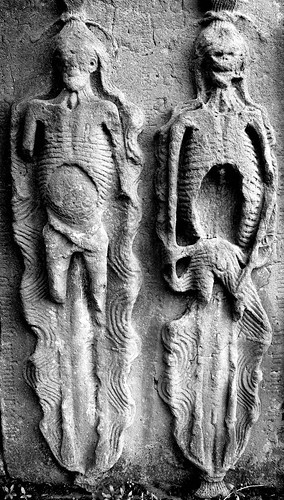 Tomorrow I go to another anatomy session in the dissection lab. Skeptical I was about the relevance of dissection to drawing and learning anatomy for artists. The cadaver too messy would be I thought. But trust I must have in the force...dissection and anatomy is quite useful to the artist interested in learning how to draw the figure more realistically, indeed.
Tomorrow I go to another anatomy session in the dissection lab. Skeptical I was about the relevance of dissection to drawing and learning anatomy for artists. The cadaver too messy would be I thought. But trust I must have in the force...dissection and anatomy is quite useful to the artist interested in learning how to draw the figure more realistically, indeed. Alas! I was happy to be able to extinguish my skepticism. (Wise) Yoda-talk aside...It has already given me a greater structural and constructional knowledge in my figure drawings and I look forward to tomorrow's session.
However I dread the formaldehyde. It's not a very strong smell, but it's enough to make me want to gag some moments. There are two aisles of gurneys with about a dozen cadavers lined up in each row. I've only seen the face of one cadaver and I am very thankful for those who have donated their bodies to science. It is difficult to look at some with skin discoloration though overall it wasn't very scary to see the cadaver's face. Perhaps because I've been to several funerals in the past and have grown somewhat desensitized to the waxy look of the dead?
However I dread the formaldehyde. It's not a very strong smell, but it's enough to make me want to gag some moments. There are two aisles of gurneys with about a dozen cadavers lined up in each row. I've only seen the face of one cadaver and I am very thankful for those who have donated their bodies to science. It is difficult to look at some with skin discoloration though overall it wasn't very scary to see the cadaver's face. Perhaps because I've been to several funerals in the past and have grown somewhat desensitized to the waxy look of the dead?
The first time I went to a dissection class (in high school) I hadn't attended a funeral nor was I ready for the formaldehyde. The shock of seeing a dead human being was very powerful and created a highly memorable experience in my mind. I think it may have greatly impacted my career choices.
Now back to the current dissection lab....It was actually more shocking to see their hands and stare at the delicate and graceful fingers and fingernails of some of the cadavers. Most of the cadavers' hands were still intact and frozen via rigor mortis. You didn't have to stare very long to feel the articulate-ness of their hands and suddenly remember that these were once alive human beings. Sometimes I would forget they were cadavers for a split second then suddenly the clinical atmosphere, the lecture, and mummy-lumps on each gurney wrapped in white plastic would rush me into reality. The two thoughts would juxtapose for a brief second. It was very strange.
Where does the vanity come in? Fat. I am a little embarrassed to admit that the greasy, yellow fat was something I just couldn't get over. I still can't fathom the inches of fat average persons contain just below their skin!! I looked at my own flesh and wondered what I looked like underneath. I couldn't stand to look at the fattier cadavers. The bright yellow grease called out to me like neon lights and all I wanted to do was turn away and go to the more lean cadavers so as not to have to face the human insulation many of us so dearly depend on for warmth. It affected me so much that I had a nightmare about it. While most people were probably haunted by the muscles and how they looked so much like any other animal meat we carnivores eat, I just couldn't get the image of the oily human padding out of my mind. As a friend pointed out, if we were served human meat vs animal meat we wouldn't be able to tell the difference. We look so much like what we eat! And yet, I had no trouble eating meat after dissection. I guess as long as whatever I ate wasn't yellow or greasy, I was fine.